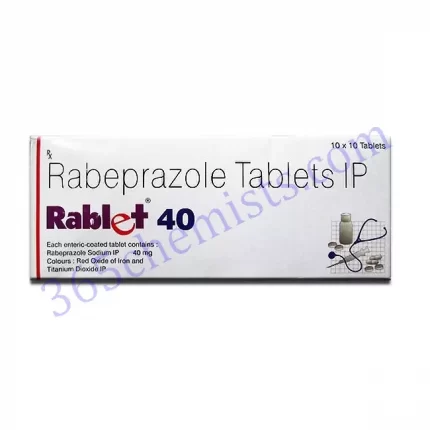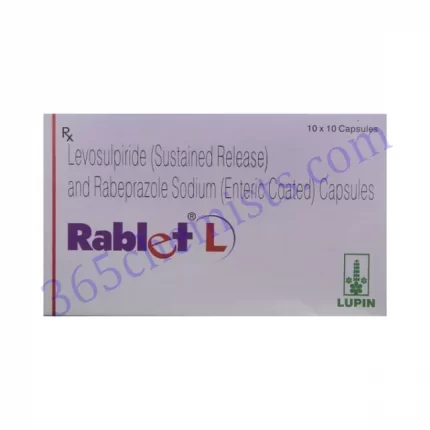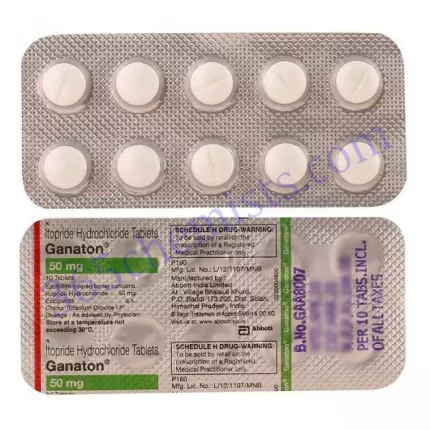Overview of Rablet D Capsule
The active ingredients in the combination drug Rablet D Capsule are Domperidone and Rabeprazole. It controls digestion and lowers the formation of stomach acid to treat gastrointestinal diseases. This thorough guide will give you crucial details about RabletD Capsule, including its mode of action, suggested dosage, potential side effects, and safety measures.
How Does Rablet D Capsule Work?
Domperidone and Rabeprazole work together in Rablet D Capsule to effectively relieve gastrointestinal symptoms. Here is how each part functions:
Domperidone (30 mg): Domperidone works on the digestive tract as a dopamine antagonist. It functions by inhibiting the brain’s and gut’s dopamine receptors, which speeds up the passage of food through the digestive system. This aids in the relief of symptoms like indigestion, bloating, nausea, and vomiting.
The proton pump inhibitor (PPI) class of drugs includes rabeprazole (20 mg). It functions by preventing the proton pump from functioning in the stomach lining, which lowers the amount of stomach acid produced. By reducing the amounts of acid in the stomach, Rabeprazole aids in the healing and prevention of stomach ulcers and lessens symptoms like heartburn and acid reflux brought on by high levels of stomach acid.
Usage and Dosage
For optimum absorption, RabletD Capsule should be taken orally, swallowed whole with water, and ideally before meals. Depending on the severity of your ailment and how you respond to the drug, a different dosage and time frame may be advised. It’s crucial to adhere to your doctor’s directions and not take more medication than is recommended.
Rablet D Capsule dosage will vary depending on your unique medical condition and how you react to treatment. It’s crucial to adhere to your healthcare provider’s recommendations for dosage and treatment duration. Without first consulting your healthcare practitioner, do not change the dosage.
Related product
Rablet 10 Tablet
Rablet 20 Tablet
Rablet 40 Tablet
Rablet D 40 Capsule
Rablet D Capsule
Rablet IT Capsule
Rablet L Capsule
Possible Side Effects
Rablet D Capsule, like many medications, might have negative effects. The most often reported adverse reactions include headache, lightheadedness, dry mouth, diarrhoea, and abdominal pain. These adverse reactions are often minor and short-lived, and they usually go away on their own without any special care. However, it’s crucial to speak with your doctor for additional assessment if you suffer severe or chronic adverse effects.
Although not everyone has adverse effects, Rablet D Capsule may cause some of them. Typical negative effects include:
Headache
Nausea
Diarrhea
Continent pain
Gas (flatulence)
Dizziness
mouth ache
Contact your healthcare practitioner for more advice if any of these adverse effects linger or get worse, or if you encounter any additional strange or severe side effects.
How to Take Rablet D Capsule
You should take Rablet D Capsule exactly as directed by your doctor. Typically, it is consumed orally with or without food. Along with a glass of water, swallow the capsule whole. Crushing, chewing, or breaking the capsule could prevent the drug from being released as intended.
Warnings and Precautions
It’s crucial to let your doctor know if you have any allergies, medical conditions, or prescription medications before taking Rablet D Capsule. Your healthcare practitioner will use this information to assess your suitability for Rablet D Capsule and, if necessary, increase your dosage.
It’s crucial to remember the following safety measures:
People who are allergic to any of the substances in RabletD Capsule shouldn’t take it.
If you have a history of liver or renal issues, let your doctor know as dosage modifications may be needed.
Before using Rablet D Capsule, check with your doctor if you are pregnant or nursing.
Inform your healthcare practitioner of all the medications you are presently taking, including over-the-counter medicines and herbal supplements, since Rablet D Capsule may interfere with some of them.
Precautions and Warnings
The following safety measures should be taken into account before taking Rablet D Capsule:
Medical history and allergies: Be sure to let your doctor know if you have any existing health issues, allergies, or drug sensitivities.
When taking Rablet D Capsule during pregnancy or during nursing, extreme caution should be exercised. For advice on how to utilise it in these circumstances, speak with your healthcare professional.
Drug interactions: RabletD Capsule may interact with a number of drugs, including antifungal, antibiotic, and anticoagulant treatments. To prevent any drug interactions, tell your healthcare professional about all the medications you are taking.
Liver and renal function: Those who use Rablet D Capsule may need to alter their dosage or be closely monitored if they have impaired liver or kidney function. If you have any underlying liver or renal issues, let your doctor know.
Conclusion
Rablet D Capsule is a combination drug that combines the effects of Domperidone and Rabeprazole to relieve gastrointestinal problems. It eases symptoms like bloating, nausea, vomiting, heartburn, and acid reflux while also regulating digestion and lowering stomach acid production. It’s crucial to take the medication as directed, be aware of any potential side effects, and speak with your doctor if you have any concerns or questions. Rablet D Capsule might be a useful therapy choice for controlling gastrointestinal issues and enhancing digestive health with proper use and direction from your healthcare practitioner.Domperidone and Rabeprazole are both ingredients of the combination drug RabletD Capsule. By controlling digestion and lowering stomach acid production, it is frequently used to treat gastrointestinal diseases. Following your healthcare provider’s dose and safety recommendations is crucial. You should also let them know if you have any adverse effects or have any other concerns so they may be addressed. To ensure maximum effectiveness and safety, your healthcare practitioner will keep track of how you are responding to the drug and make any required adjustments.












